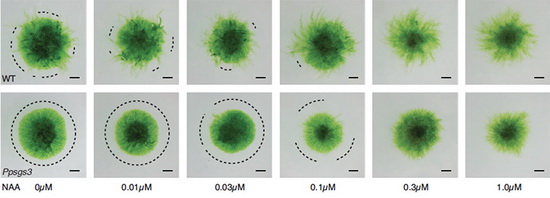
Ancient Gene Network Helps Plants Adapt to Their Environments
February 10, 2016| |
Professor Marja Timmermans and a team of scientists at Cold Spring Harbor Laboratory (CSHL) have discovered the purpose of one genetic tool that is present in both mosses and flowering plants. The tool, called small RNA, has been used to make plants more sensitive to environmental cues and facilitate responses to those cues.
Small RNAs regulate gene activity via RNA interference (RNAi). One set of small RNAs, called tasiARF, has been conserved throughout the evolution of plants. tasiARF regulates the expression of proteins called auxin response factors (ARFs). Together, the tasiARF/ARF gene network plays a role in the development of the sexual organs, roots, and leaves of flowering plants. Surprisingly, this gene network is also found in mosses, which possess none of these plant parts.
To reveal why the tasiARF gene network is conserved, researchers examined its function in the moss species Physcomitrella patens response to auxin. The researchers discovered that tasiARF makes the moss more sensitive to auxin and makes the expression of genes that are stimulated by auxin more stable. Auxin affects plant development in a range of different ways, making regulation of the response to this hormone a key priority for plants.
The research group also discovered that some cells of the moss have high levels of tasiARF, and are more responsive to auxin, while some do not, and are less responsive to the hormone. This ability of tasiARF to promote a sensitive and robust auxin response, as well as to spatially regulate this response within the plant, made it such an indispensable tool over 450 million years of plant evolution.

Read the full article in CSHL News.
| |
Biotech Updates is a weekly newsletter of ISAAA, a not-for-profit organization. It is distributed for free to over 22,000 subscribers worldwide to inform them about the key developments in biosciences, especially in biotechnology. Your support will help us in our mission to feed the world with knowledge. You can help by donating as little as $10.
-
See more articles:
-
News from Around the World
- Naturally Occurring Plant Enzyme to Increase Wheat Yields
- "Molecular Memory" Helps Plants Remember Daylight During Winter
- Study Explains How Corn Plants Fight Off Simultaneous Attacks
- Ancient Gene Network Helps Plants Adapt to Their Environments
- Charu Mayee Awarded "Majha Sheti Sanman Puraskar"
- Punjab Seed Council Approves New Seedless Citrus
- 4th Public Consultation Held for Revised GM Regulatory Guidelines in the Philippines
- Vitamin B6 Role in Plants Discovered
- Scientists Uncover Signalling Pathway of Long-Established Immune Receptor
-
Research Highlights
- Comparative Analysis of Cotton Near Isogenic Lines Reveal Genes Related to High Fiber Strength
- Metabolic Engineering of Terpene Biosynthesis using a Transcription Factor MsYABBY5 from Spearmint
- Development of a Novel Transgenic Cotton to Control Bollworm
-
Beyond Crop Biotech
- Researchers Identify Genetic Makeup of Dangerous E. coli Strains
- WSU Researchers Discover How a Helpful Protein Can also Cause Cancer
-
From the BICs
- Philippine and Thailand BICs Join Cornell Alliance for Science Asia Leadership Course
-
Read the latest: - Biotech Updates (April 17, 2024)
- Gene Editing Supplement (April 10, 2024)
- Gene Drive Supplement (February 22, 2023)
-
Subscribe to BU: - Share
- Tweet
